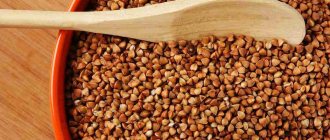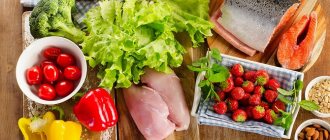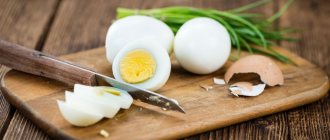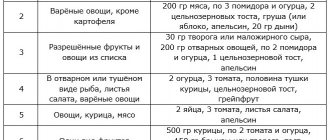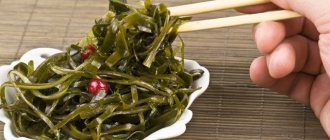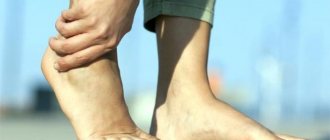The quality of nutrition has a significant impact on the health and condition of the body. By taking into account individual characteristics in the diet, using a special diet, you can correct certain problems inherent in the body.
Thus, for functional diseases and disorders of the nervous system, experts recommend using the “Table No. 12” therapeutic diet, developed in the 1930s by Manuil Isaakovich Pevzner, the founder of dietetics in the USSR, the author of 15 therapeutic diets.
Modern research in the United States also confirms the important role of human nutrition and lifestyle in the fight against neurological disorders.
In this article we will look at the essence of diet No. 12 according to Pevzner and what are the specific indications for following it.
The essence and purpose of the diet
A diet, often in addition to the main treatment, is prescribed for identified functional disorders and diseases of the nervous system.
Its beneficial effect is determined, firstly, by reducing the amount of carbohydrates, fat, salt consumed, and secondly, by the complete exclusion of central nervous system pathogens from the diet.
The latter include caffeine-containing drinks (coffee, tea, etc.), spicy foods, and foods fried in copious amounts of fat or oil.
Specific indications for prescribing diet No. 12 primarily include the following:
- diseases and disorders of the central nervous system (depression, neuroses, sleep disorders and emotional reactions);
- transition from therapeutic diet No. 10 (prescribed for diseases of the cardiovascular and circulatory systems) to rational nutrition.
We also recommend paying attention to the MIND diet to improve brain function.
Additional measures for nervous system disorders
Table No. 12 is used for sleep disorders, anxiety, feelings of fear, and decreased ability to work. These conditions may be a sign of a deficiency of beneficial components, which can be caused by poor, irregular nutrition and chronic stress.
Patients with disorders of the nervous system need to include in their diet a sufficient amount of fiber, which is rich in vitamin B. This vitamin is especially useful for improving the functioning of the nervous system. It can be obtained from fruits, grains, cereals
Also, foods rich in fiber have detoxifying and antioxidant effects, which is very important in increasing the body's immune defense and strengthening the nervous system.
Drinking regime is also important. For diseases of the nervous system, it is necessary to drink sufficient amounts of purified water.
However, you need to remember that you should not drink water with food (or other drinks either) or drink it an hour before bedtime.
If the disease is accompanied by muscle spasms, tics, and other involuntary movements, it is recommended to consume more phosphorus. It is found in dairy products, liver, legumes, tongue, and brains.
For neurasthenia, increased excitability, nervousness, and unreasonable attacks of aggression, you need to eat food with magnesium. It normalizes blood pressure and pulse, has a calming effect, and has a positive effect on the functioning of the heart muscle. To make up for its deficiency, you need to add lentils, beans, chickpeas, buckwheat, nuts, and bran to the menu. The cause of the same irritability and seizures can be calcium deficiency. In addition to dairy products, they are rich in: beets, almonds, cabbage, and beans.
To improve brain activity, attention, and memory, it is recommended to introduce foods rich in iron into the diet. It can be obtained from white cabbage, turnips, seafood, buckwheat, and beef. In order for iron to be better absorbed, you need to add vitamin C to the menu. In addition to citrus fruits, there is a lot of it in berries: strawberries, rose hips, black currants.
After suffering stress, you need to consume more vitamin E. This element improves the activity of brain cells, and also has a beneficial effect on the functioning of the central and peripheral nervous systems, and regulates the emotional background. It can be found in sprouted wheat, peas, beans, lentils, eggs, and nuts.
For mild neuroses, excitability, neurasthenia and other functional disorders of the central nervous system, walks in the fresh air are mandatory. For frequent stress, short-term nervous tics, and aggression, it is recommended to add reading positive books (“Dandelion Wine” by Ray Bradbury, “Pollyanna” by Eleanor Porter, “Three Cups of Tea” by Greg Mortenson and others).
General rules
As stated above, a diet involves avoiding consumption of certain food groups and limiting consumption of others.
In addition, an important component of the diet is to increase the consumption of healthy nutrients. As part of this diet, these include, first of all, those saturated with phosphorus salts (liver, legumes, dairy products).
As for the values of substances consumed from food and the distribution of the share of protein, fat and carbohydrate consumption, for diet Table No. 12 they are determined as follows for one day:
| Index: | Meaning: | Note: |
| Proteins: | From 80 to 95 grams; | The share of animal protein is from 50 to 60%; |
| Carbohydrates: | 350 grams; | — |
| Fats: | 70 grams; | At least 30% of fats are of vegetable origin; |
| Salt: | 6 grams; | — |
| Number of calories: | 2300-2400 kcal; | Depends on the individual characteristics of the body. |
The diet regimen is five meals a day. In addition, it is important to ensure that you regularly consume food at the same time every day. This not only helps to improve the functional effect of the diet, but also stimulates better metabolism and the absorption of nutrients from the food consumed.
"Black and blue countdown." Number 12. The most goalkeeper number, not counting the first
Number 12 was traditionally given to reserve goalkeepers. In the history of Inter, many great future goalkeepers tried it on: Lido Vieri, Ivano Bordon, Walter Zenga. Having become the main gatekeepers, they traditionally changed their number to one, and the 12th again went to the challenger.
Things turned out a little differently for Julio Cesar. The Brazilian, who moved to Inter in 2005, gradually ousted Francesco Toldo from the squad, but did not change his number 12 to number 1 out of respect for his legendary colleague. So, wearing a sweater with the number 12 on the back, Cesar went down in history as the winner of the 2010 Champions League, the best goalkeeper of that season and a four-time Scudetto winner. Only after Toldone retired in the summer of 2010 did the Brazilian take the coveted one. Unfortunately, soon after this, Julio Cesar's play began to decline, he lost his former reliability and soon left Inter.
By the way, a few words about Toldo: perhaps the main tournament of his career, in which he showed perhaps the most brilliant goalkeeping performance that our generation has ever seen, he played in the 12th number. The first number in Italy's application for Euro 2000 was... Christian Abyatti, who had not played for the national team at that time.
But let's return to Inter. The last goalkeeper to wear number 12 on his back was Luca Castellazzi, Inter's second-choice goalkeeper from 2010 to 2014, who came in to replace Toldo as a seasoned veteran on the bench. A native Lombardian (Castelazzi was born in a suburb of Milan with the gastronomic name Gorgonzola, which is the birthplace of the cheese of the same name) moved to the team from his hometown only at the age of 35, having played plenty in both Genoa and Sicily. Since his departure in 2014, no goalkeeper has worn number 12 on the field.
But in 2015, Alex Telles unexpectedly received this number. The Brazilian, rented for the season from Galatasaray, was not remembered for anything outstanding and left for Portugal, where Brazilians are traditionally comfortable. This year, Telles is trying his hand at Manchester United. Alex is 28 years old, in his prime, so his second attempt to gain a foothold in the “big” championship may turn out to be more successful - we’ll see.
After that, for several years, players with number 12 did not appear on the field for Inter. In Italy, by the way, there is a popular idea to retire number 12, dedicating it to the fans. He was forever attached to the fans of seven clubs that played at that time in Serie A: Atalanta, Genoa, Cesena, Lazio, Palermo, Parma and Torino. But at Inter, instead, the 12th number last season was again given to a field player - Stefano Sensi.
The reason that Sensi chose the traditional goalkeeper number for himself is very simple: Stefano played in goal as a child. Yes, it’s hard to imagine it now, because Sensi’s height is only 168 centimeters, but, however, the best goalkeeper of France of the 20th century, Julien Daruy, had the same height. And the legend of the Mexican national team, Jorge Campos, who played 130 matches for the Greens, is also exactly 168 centimeters tall. This did not hinder their brilliant careers. So, if something happens to Samir and we run out of replacements, we know who we can rely on. The main thing is that the talented and bright midfielder Stefano Sensi finally gets out of the series of injuries that have been plaguing him.
Authors of Canale Sforzesco: Daniil Shulman-Simakov, Dmitry Zolotenkov.
Canale Sforzesco on Telegram
Group about Internazionale on VKontakte
Sample menu for the week
Below is a sample menu for the week, taking into account dietary requirements. The described distribution of products during the week and each day is advisory, informational in nature and involves the formation of your own diet, taking into account the individual characteristics and intolerances of the body in each specific case. This is what the recommended menu for every day looks like:
Monday
| Meal: | Products: |
| Breakfast: | 1 egg, a glass of orange juice, a cup of herbal tea, whole grain bread, goat cheese; |
| Lunch: | 2 cheesecakes with sour cream and a glass of water (carbonated or not); |
| Dinner: | borscht with lean beef, seaweed salad, hake, rice; |
| Afternoon snack: | Apples or other seasonal fruits, herbal tea, milk; |
| Dinner: | veal, vegetable salad. |
Tuesday
| Meal: | Products: |
| Breakfast: | 1 glass of water, oatmeal with honey and dried fruits; |
| Lunch: | apples or other seasonal fruits, herbal tea, milk; |
| Dinner: | cabbage soup in chicken broth with cereal, beef, legumes; |
| Afternoon snack: | Caesar with chicken breast (without croutons), herbal tea, juice or water; |
| Dinner: | Zucchini pancakes, baked sea bass fillet. |
Wednesday
| Meal: | Products: |
| Breakfast: | millet porridge with pumpkin and honey, herbal tea, orange juice or grapefruit; |
| Lunch: | red grapes, 2 cheesecakes with honey, jam or sour cream, water; |
| Dinner: | vegetable soup (minestrone), falafel, fried cheese; |
| Afternoon snack: | cookies, dried fruits and hibiscus tincture (hibiscus); |
| Dinner: | durum wheat pasta with seafood and cream sauce. |
Thursday
| Meal: | Products: |
| Breakfast: | 2 eggs, orange juice, hummus with whole grain bread; |
| Lunch: | fruits or dried fruits, honey, nuts and cranberry juice; |
| Dinner: | Lean fish soup, seaweed or soy asparagus, beef, chicken or turkey cutlets; |
| Afternoon snack: | cookies with milk/cottage cheese; |
| Dinner: | fried red mullet with a side dish of rice, vegetables or a small portion of baked potatoes. |
Friday
| Meal: | Products: |
| Breakfast: | cheesecakes with honey or sour cream, a glass of water, yogurt; |
| Lunch: | cottage cheese, bananas, herbal tea; |
| Dinner: | soup with meatballs, lean lamb with vegetable side dish, hot herbal tea; |
| Afternoon snack: | salad of beans, tomatoes and tuna, flavored with mild spices and vegetable oil, whole grain bread; |
| Dinner: | red or brown wild rice, pike cutlets, vegetables. |
Saturday
| Meal: | Products: |
| Breakfast: | 2 cheesecakes with sour cream, honey or jam, nuts, herbal tea; |
| Lunch: | 1 grapefruit, bananas, mangoes or peaches; |
| Dinner: | soup with meat or chicken broth with cereals, vegetable salad, lean beef or beef tongue; |
| Afternoon snack: | rice porridge with milk, herbal tea or water; |
| Dinner: | salad (warm) with cod liver and boiled egg, whole grain bread. |
Sunday
| Meal: | Products: |
| Breakfast: | oatmeal with apple or berries, nuts and honey, 2 glasses of water; |
| Lunch: | beef liver with whole grain bread, jelly or fruit drink; |
| Dinner: | soup with meat or chicken broth with cereals, lean fish with rice or vegetable side dish; |
| Afternoon snack: | fruits, cereals, nuts, dried fruits, honey, herbal tea. |
| Dinner: | Veal medallions with vegetable salad, water. |
Products can be varied taking into account the above recommendations for consumption: replace meat with liver, replace some fruits with others (taking into account the principle of seasonality, providing benefits and protection from the entry into the body of unwanted elements used as growth stimulants).
Table No. 10 according to Pevzner
Table No. 10. Represents a complete diet with limited consumption of table salt and liquid. This diet has found wide application and is used for diseases of the cardiovascular system in a state of compensation and subcompensation, hypertension, atherosclerosis and kidney diseases.
Indications: diseases of the cardiovascular system (rheumatism and heart defects, hypertension, coronary artery disease), circulatory failure stage I-11A, diseases of the nervous system, chronic nephritis and pyelonephritis only with changes in urine sediment.
General characteristics: diet with a limit of table salt to 6-8 g (3-4 g in foods and 3-4 g in the hands of the patient), free liquid 1.2 liters (including soups, jelly, etc.). Substances that excite the central nervous system and cardiovascular system are excluded, i.e. all types of alcoholic drinks, strong tea and natural coffee, cocoa, chocolate, meat, fish and mushroom broths, spicy dishes, smoked meats, foods rich in cholesterol. Products that cause flatulence are limited. Products with predominantly alkaline valencies (milk and dairy products, fruits, vegetables and juices from them) and rich in lipotropic substances (cottage cheese, cod, oatmeal, etc.) are recommended.
Ingredients: proteins 90 g (of which 50 g are animal), fats 65-70 g (of which 20 g are vegetable), carbohydrates 350-400 g, table salt up to 6-8 g.
Energy value: 2,350-2,600 kcal (9,839-10,886 kJ).
Culinary processing: with moderate mechanical gentleness, all dishes are prepared without salt, meat and fish - boiled or followed by baking and frying.
Diet: meals 5-6 times a day in moderate quantities, dinner 3 hours before bedtime. In case of cardiovascular diseases, the administration of free fluid is limited to 1,000-1,200 ml.
Food temperature: normal.
weak tea, coffee drinks, fruit and vegetable juices, compotes, jelly, rosehip decoction, limited grape juice.
wheat bread made from 1st and 2nd grade flour, freshly baked yesterday or slightly dried, dietary salt-free bread, savory cookies and biscuits.
unsalted butter and ghee, vegetable oils.
lean varieties of beef, veal, pork, rabbit, chicken, turkey. After boiling, baking or frying is allowed. Lean fish, boiled, jellied. Boiled sausages are limited.
Eggs up to 1 pc. per day, soft-boiled, in the form of baked or egg white omelettes, or added to dishes.
Soups – serving 250–400 g. Various vegetarian with the addition of cereals and vegetables. For example, beetroot soup, borscht, cabbage soup. It is allowed to add sour cream and herbs.
Various cereal dishes: porridge, casseroles. Boiled pasta.
Fermented milk drinks, cheese, cottage cheese and curd dishes, milk if tolerated.
Boiled, baked or raw vegetables: potatoes, carrots, beets, zucchini, pumpkin, tomatoes, lettuce, cucumbers. White cabbage and green peas in limited quantities. Green onions, dill, parsley are added to dishes.
Soft ripe fruits and fresh berries, dried fruits.
Jelly, mousses, milk jelly and creams, jam, honey, non-chocolate candies.
fresh bread, butter and puff pastry products;
meat, fish and mushroom broths;
fatty meats and fish, duck, goose, liver, kidneys, brains;
smoked meats, sausages, canned meat and fish, caviar, salty and fatty cheeses;
hard-boiled and fried eggs;
Several suitable recipes
Below are several recipes that meet your diet requirements.
Hake in Moscow style
A simple and tasty dish suitable for lunch or dinner. What you will need:
- hake – 500 grams;
- potatoes – 1 kg;
- tomatoes – 500 grams;
- cheese – 200 grams;
- green onions - several pods.
It is prepared as follows:
- Preheat the oven to 200°C. N
- and on a baking sheet greased with vegetable or butter, the potatoes cut into slices are placed.
- Hake fillet cut into small pieces is laid out on top.
- Place on top in layers: tomatoes (in rings), potatoes, grated cheese. It is important to cut the potatoes thin enough so that the cooking time roughly coincides with the time the fish is ready.
- The cooking process in the oven takes 30-45 minutes.
If desired, the dish can be seasoned with green onions.
Veal stewed with vegetables
What you will need:
- veal – 500 grams;
- zucchini – 200 grams;
- eggplants – 200 grams;
- tomatoes – 1-2 small tomatoes;
- celery (root) – 1-2 pieces;
- bell pepper – 1-2 pieces.
The recipe is just as simple:
- Line a baking sheet with foil and preheat the oven to 200-220°C.
- Cut all the ingredients into small cubes, lightly grease with oil, add salt and pepper, and mix together.
- Cover the baking sheet with foil (tightly), use a toothpick to make several holes for better air circulation.
- Prepares in 60-80 minutes.
Serve garnished with fresh herbs (kenza and parsley work best).
Short answer
The number 12 actually exists, but athletes with this number are rarely seen on the field. This is due to the fact that in football there is a tradition of assigning number 12 to fans. This is what FC Zenit, PSV, CSKA, Bayern and others did. This tradition arose, according to legend, after a 1922 match in the USA, when the team needed another player and had to turn to the fans. John Bible was the lucky one. Assigning numbers to football players is a very important thing for them. They take numbers according to their positions on the field and other factors. Numbers are also assigned to outstanding athletes for their services to the club.
Interesting: How and from what is chewing gum made? Description, photo and video
If you find an error, please select a piece of text and press Ctrl+Enter.


